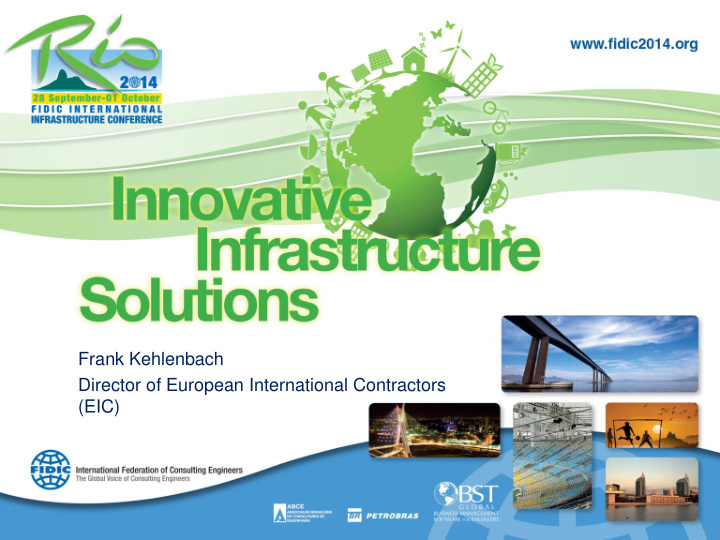



Frank Kehlenbach Director of European International Contractors (EIC)
FIDIC standard forms as risk mitigation tool FIDIC standard forms of contract have historically allocated the construction risk fairly , i.e. on the basis of which party is best placed to assume individual risks Provide the lowest outturn cost , as bidders do not have to price for potential risks Avoid any possibility of arbitrary interpretations and actions by one of the parties IMPACT OF FAIR CONDITIONS IMPACT OF UNFAIR CONDITIONS Co-operation / Teamwork Claims, Disputes, Penalties Quality works Poor quality works Profitability Insolvencies / Bankruptcies Professionalism & Integrity Corruption / Cartels
FIDIC standard forms have become more risky for contractors over time In the “good old times” , the first three FIDIC “Red Book” editions were agreed and published jointly by FIDIC and the world’s regional contractors’ federations Contractor was obliged to design (to the extent provided for by the Contract), execute and complete the Works with due care and diligence (not fitness for purpose) Existence of a trusted and independent Engineer able to operate as experienced contract administrator was welcomed as a value added by both contractor and employer
FIDIC standard forms have become more risky for contractors over time In 1987, consensus between FIDIC and international contractors – which had existed for three decades – ended and FIDIC became the sole publisher of the 4 th edition of its “Red Book” Reason was irreconcilable standpoints with respect to the role of the impartial and independent Engineer In 1996 supplement, DABs were introduced Collaboration between FIDIC and contractors was remodeled ( “friendly reviewer” )
FIDIC standard forms have become more risky for contractors over time In 1999, FIDIC published an unbalanced standard form with enormous risk for contractors . EIC comment: “Whilst it is not difficult to draft conditions that appeal to employers, FIDIC has always endeavoured to explain to prospective Employers the reason behind the allocation of certain risks . By leaving the traditional FIDIC philosophy behind and instead in the Silver Book taking on-board the “ all risks on the contractor - philosophy” , FIDIC will contribute to poor contract practices . In the end, it does not serve employers generally that unreasonable conditions are imposed on contractors . Employers will have to pay the costs for construction and it must be most fair that the cost to execute a particular project is borne by the owner of the project.”
FIDIC standard forms have become more risky for contractors over time Employer’s contractual rights are unreasonably Contractor’s expanded or duties contractual rights are reduced unreasonably limited or duties expanded Engineer’s or DAB’s powers are restricted or deleted F A I R C O N T R A C T C O N D I T I O N S
FIDIC standard forms have become more risky for contractors over time Typical re- allocation of risk in Particular Conditions of fair “FIDIC” forms Event Time Cost Cost plus Profit X X X Delayed Drawings or Instructions X X X Right of Access to the Site X X Fossils X X X Setting Out, Ground conditions Exceptionally adverse climatic X X conditions Consequences of Suspension by X X Employer Adjustment for Changes X X in Legislation X X Consequences of Employer’s Risks X
FIDIC standard forms have become more risky for contractors over time In 2010 , MDBs adopted the FIDIC “Pink Book” as the standard form of contract used by MDBs for construction projects for which they provide finance Participating banks and FIDIC have amended the General Conditions of the FIDIC 1999 Red Book and have also diminished the role of the Engineer WB Procurement Reform : FIDIC forms of contract will probably no longer be imposed by MDBs as exclusive set of general conditions but will be one of several options available to borrowers
Consequences of too risky contract conditions If the risks to the Contractor become excessively high , the following problems may occur: Higher bid price Bid failure & disruption of project implementation Contract award to bidder who fails or not capable of estimating risks properly Poor construction quality and delay of the work Undermining the relationship of mutual trust and respect between parties Groundless claims from the contractor Frequent disputes between the employer and the contractor In extreme cases eventual termination of the contract JICA Checklist for One-Sided Contracts (March 2011)
EIC Contractor’s Guides flag FIDIC risk profile International Construction Law Review, October 2011 (Introduction) They [the EIC Contractor’s Guides] are valuable as they are the product of a responsible and reputable international organisation . They also throw a light on the approaches to be adopted in drafting international construction contracts... As in the past, EIC’s comments are balanced . They indicate what it regards as improvements and what it believes to be retrogressions .
Conclusions & Outlook FIDIC standard forms of contract 1999 contain a greater deal of risk for contractors when compared with earlier forms of the last century FIDIC’s market core , the ”trusted and independent Engineer” who can afford to make fair decisions , is often eliminated by ill-advised clients Necessity for FIDIC (and its Member Federations) to raise awareness of the negative effects connected with the uninhibited misuse of FIDIC forms vis-à-vis clients and their financiers remains a daily concern Given that the “Silver Book” goes to the extreme by allocating construction risk to the contractor, FIDIC might consider to serve the international contracting market by publishing a more collaborative and “innovative” standard form of contract at the opposite end of the spectrum
EIC Contact Address: EIC Secretariat Kurfuerstenstrasse 129, D - 10785 Berlin, Germany Phone: ++49 (0)30 /21286-244 Fax: ++49 (0)30 /21286-285 E-mail: info@eic-federation.eu Internet: www.eic-federation.eu
Recommend
More recommend